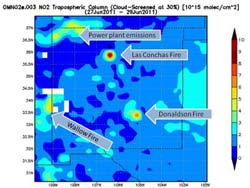NASA's Aura Satellite measures pollution from New Mexico, Arizona fires

This image from the OMI instrument on NASA's Aura satellite shows nitrogen dioxide levels from June 27 to 29, 2011 in New Mexico and Arizona pertaining to three large fires. The highest levels of NO2 were from the Las Conchas fire (red). The NO2 is measured by the number of molecules in a cubic centimeter. Credit: NASA/James Acker<br>
The fierce Las Conchas fire threatened the town and National Laboratory in Los Alamos, while smoke from Arizona's immense Wallow Fire and the Donaldson Fire in central New Mexico also created nitrogen dioxides (NO2) detectable by the Ozone Measuring Instrument (OMI) that flies aboard NASA's Aura satellite.
An image showing nitrogen dioxide levels from June 27 to 29, 2011 was created from OMI data using the NASA Giovanni system by Dr. James Acker at NASA's Goddard Space Flight Center in Greenbelt, Md. The highest levels of NO2 were from the Las Conchas fire. The NO2 is measured by the number of molecules in a cubic centimeter.
Low-level ozone (smog) is hazardous to the health of both plants and animals, and ozone in association with particulate matter causes respiratory problems in humans.
On July 1, Inciweb reported that the Las Conchas fire is currently burning on 93,678 acres and was three percent contained. An infrared flyover at 4 a.m. MDT on July 1 reported 103,842 acres burned. InciWeb is the “Incident Information System” website that reports wildfire conditions throughout the country.
The Donaldson fire is estimated to cover 72, 650 acres and is located to the southeast of the Las Conchas fire. Inciweb reported on July 1 that the fire is burning in the Lincoln National Forest and Mescalero-Apache Tribal lands and is not accessible. The terrain is steep and rocky. It is located about 10 miles northwest of Ruidoso Downs, N.M.
Inciweb reported on July 1 that “smoke from the fire is impacting the communities of Ruidoso, Ruidoso Downs, Capitan, Lincoln, Hondo, Fort Stanton, Picacho, Tinnie, San Patricio, Glencoe and other surrounding areas.” In east central Arizona, the Wallow Fire is now 95 percent contained, according to InciWeb. Total acres burned are 538,049, including 15,407 acres in New Mexico.
Emissions from coal-burning power plants located in northwest New Mexico were also visible in the image.
OMI data is archived at the NASA Goddard Earth Sciences Data and Information Services Center (GES DISC), and is provided by KNMI, the Koninklijk Nederlands Meteorologisch Instituut (Royal Netherlands Meteorological Institute). Dr. P.F. Levelt is the Principal Investigator of OMI, Dr. J. Tamminen is the Finnish Co-PI, and Dr. P.K. Bhartia leads the U.S. OMI science team. Dr. James Gleason (NASA) and Pepijn Veefkind (KNMI) are PIs of the OMI NO2 product.
For more information about the Aura Satellite's OMI instrument, visit:
http://aura.gsfc.nasa.gov/instruments/omi.html
For more information about NO2 and ground level ozone pollution:
http://tes.jpl.nasa.gov/mission/O3SourceSink/
Media Contact
More Information:
http://www.nasa.govAll latest news from the category: Ecology, The Environment and Conservation
This complex theme deals primarily with interactions between organisms and the environmental factors that impact them, but to a greater extent between individual inanimate environmental factors.
innovations-report offers informative reports and articles on topics such as climate protection, landscape conservation, ecological systems, wildlife and nature parks and ecosystem efficiency and balance.
Newest articles

Bringing bio-inspired robots to life
Nebraska researcher Eric Markvicka gets NSF CAREER Award to pursue manufacture of novel materials for soft robotics and stretchable electronics. Engineers are increasingly eager to develop robots that mimic the…

Bella moths use poison to attract mates
Scientists are closer to finding out how. Pyrrolizidine alkaloids are as bitter and toxic as they are hard to pronounce. They’re produced by several different types of plants and are…

AI tool creates ‘synthetic’ images of cells
…for enhanced microscopy analysis. Observing individual cells through microscopes can reveal a range of important cell biological phenomena that frequently play a role in human diseases, but the process of…





















